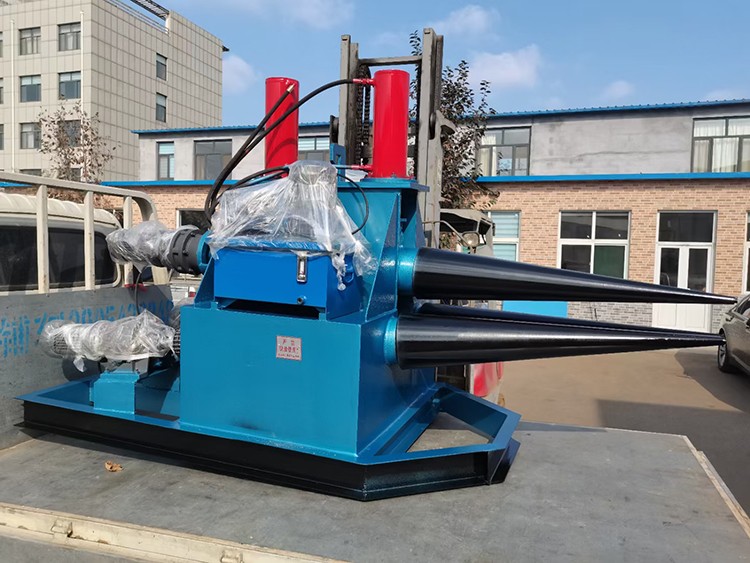

After a decade of dedication, we have grown into a professional manufacturer in the field of cone rolling machine manufacturing. Today, we will reveal the correct adjustment of the roller shaft spacing in cone rolling machines:

A cone rolling machine is a specialized piece of equipment used for processing conical workpieces. The accurate adjustment of its roller shaft spacing directly impacts product quality and production efficiency. This article will provide a detailed overview of the adjustment steps and precautions for the roller shaft spacing of a cone rolling machine.
1. Preparations before adjustment
(1)Equipment inspection
Before adjustment, it is essential to ensure that the equipment is in a safe condition. Disconnect the power supply and lock the energy source, then check that all moving parts have come to a complete stop. Confirm that the hydraulic system pressure has been released and that the safety protection devices are intact and effective.
(2)Tool preparation
Prepare the necessary adjustment tools, including:
Special spacing gauge
Dial indicator (accuracy 0.01 mm)
Feeler gauge set
Level
Torque wrench
Parameter confirmation
Review the process documentation to determine the roll spacing parameters required for the current processing task. Understand the material properties, including thickness, strength, and rebound coefficient.
2. Mechanical adjustment steps
(1)Initial position calibration
Move the roller shaft to the initial reference position and use a level to check the levelness of the roller shaft. The error should be controlled within 0.05 mm/m. Check the parallelism of the roller shaft to ensure that the distance between the two ends is consistent.
(2)Coarse adjustment stage
Loosen the fixing bolts, retaining appropriate preload. Adjust the roller shaft spacing preliminarily according to process requirements. Perform preliminary measurements using a measuring gauge, allowing for an error of up to 0.5 mm.
(3)Fine adjustment stage
Perform precise adjustments using the fine adjustment mechanism:
Adjust in increments of 0.1 mm
Measure the actual distance after each adjustment
Repeat the operation until the target value is reached
(4)Fastening and verification
Fasten all fixing bolts according to the standard torque value, using a cross-symmetrical fastening sequence. Re-measure the spacing and confirm that the adjustment results meet the requirements.
3. Control system settings
(1)Parameter input
Enter the adjusted spacing parameters in the CNC system, including:
(2)Reference position coordinates
(3)Travel limit values
(4)Speed parameters
(5)Zero point calibration
Perform reference point reset operation to establish an accurate coordinate system. Calibrate the position sensor to ensure accurate feedback signals.
(6)Motion Test
Perform a low-speed no-load operation test to observe whether the roller shaft moves smoothly without abnormal vibration or noise.
4. Actual processing verification
(1)Trial processing
Use a process test plate for actual rolling and observe the forming effect. Focus on:
Taper accuracy
Surface quality
Dimensional accuracy
Measurement inspection
Use special gauges to measure the dimensions of the workpiece, focusing on checking:
Large end diameter
Small end diameter
Taper surface straightness
Parameter optimization
Fine-tune the spacing parameters based on the trial machining results. It usually takes 2-3 adjustments to achieve the best results.
5. Key points for daily maintenance
(1)Regular inspections
Check the stability of the roller shaft spacing weekly and thoroughly inspect the transmission system precision monthly. Establish equipment precision records and record the inspection results.
(2)Lubrication and maintenance
Add lubricant regularly in accordance with equipment requirements, paying particular attention to the lubrication status of the guide rails and lead screws. Use the specified type of lubricating grease.
(3)Operating procedures
Operate the equipment strictly in accordance with the procedures and avoid overloading it. Stop the machine immediately for inspection if any abnormalities are found, and do not operate the machine while it is malfunctioning.
6. Troubleshooting
(1)Unstable spacing
Check the transmission system clearance, focusing on:
Screw nut wear
Guide rail clearance
Loose coupling
Difficult adjustment
Possible causes:
Poor lubrication
Mechanical deformation
Insufficient hydraulic pressure
Poor machining accuracy
Analysis of influencing factors:
Improper spacing settings
Material rebound
Mold wear
7. Safety precautions
(1)The power source must be disconnected when making adjustments.
(2)Do not make adjustments while the equipment is running.
(3)Use appropriate tools and avoid rough handling.
(4)When working with multiple people, follow unified commands.
(5)After completing adjustments, thoroughly check the safety devices.
The adjustment of the roll spacing of a roll forming machine requires a combination of mechanical adjustment and parameter settings. Operators should master the correct adjustment methods and ensure adjustment accuracy through standardized procedures and meticulous operations. It is recommended to establish a comprehensive equipment inspection system, perform regular maintenance and servicing, and maintain the equipment in optimal working condition. At the same time, operator training should be strengthened to improve technical skills and safety awareness, providing a reliable guarantee for the production of high-quality products.
If you are interested in cone rolling machines, please contact us.
 Address:Room 1202, Detaitang Building, No. 118 Huaguang Road, Zhangdian District, Zibo, Shandong
Address:Room 1202, Detaitang Building, No. 118 Huaguang Road, Zhangdian District, Zibo, Shandong WhatsApp:+8615653328535
WhatsApp:+8615653328535 Wechat: +8615965331535
Wechat: +8615965331535  E-mail:zs@sdsmachinery.com
E-mail:zs@sdsmachinery.com